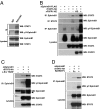ephrinB1 signals from the cell surface to the nucleus by recruitment of STAT3
- PMID: 17954917
- PMCID: PMC2077252
- DOI: 10.1073/pnas.0702337104
ephrinB1 signals from the cell surface to the nucleus by recruitment of STAT3
Abstract
The Eph (erythropoietin-producing hepatoma) family of receptor tyrosine kinases and their membrane-bound ligands, the ephrins, have been implicated in regulating cell adhesion and migration during development by mediating cell-to-cell signaling events. The transmembrane ephrinB (Eph receptor interactor B) protein is a bidirectional signaling molecule that sends a forward signal through the activation of its cognate receptor tyrosine kinase, residing on another cell. A reverse signal can be transduced into the ephrinB-expressing cell via tyrosine phosphorylation of its conserved C-terminal cytoplasmic domain. Although some insight has been gained regarding how ephrinB may send signals affecting cytoskeletal components, little is known about how ephrinB1 reverse signaling affects transcriptional processes. Here we report that signal transducer and activator of transcription 3 (STAT3) can interact with ephrinB1 in a phosphorylation-dependent manner that leads to enhanced activation of STAT3 transcriptional activity. This activity depends on the tyrosine kinase Jak2, and two tyrosines within the intracellular domain of ephrinB1 are critical for the association with STAT3 and its activation. The recruitment of STAT3 to ephrinB1, and its resulting Jak2-dependent activation and transcription of reporter targets, reveals a signaling pathway from ephrinB1 to the nucleus.
Conflict of interest statement
The authors declare no conflict of interest.
Figures





References
-
- Palmer A, Klein R. Genes Dev. 2003;17:1429–1450. - PubMed
-
- Flanagan JG, Vanderhaeghen P. Annu Rev Neurosci. 1998;21:309–345. - PubMed
-
- Gale NW, Holland SJ, Valenzuela DM, Flenniken A, Pan L, Ryan TE, Henkemeyer M, Strebhardt K, Hirai H, Wilkinson DG, et al. Neuron. 1996;17:9–19. - PubMed
-
- Cowan CA, Henkemeyer M. Nature. 2001;413:174–179. - PubMed
-
- Lu Q, Sun EE, Klein RS, Flanagan JG. Cell. 2001;105:69–79. - PubMed
Publication types
MeSH terms
Substances
Grants and funding
LinkOut - more resources
Full Text Sources
Other Literature Sources
Molecular Biology Databases
Miscellaneous

